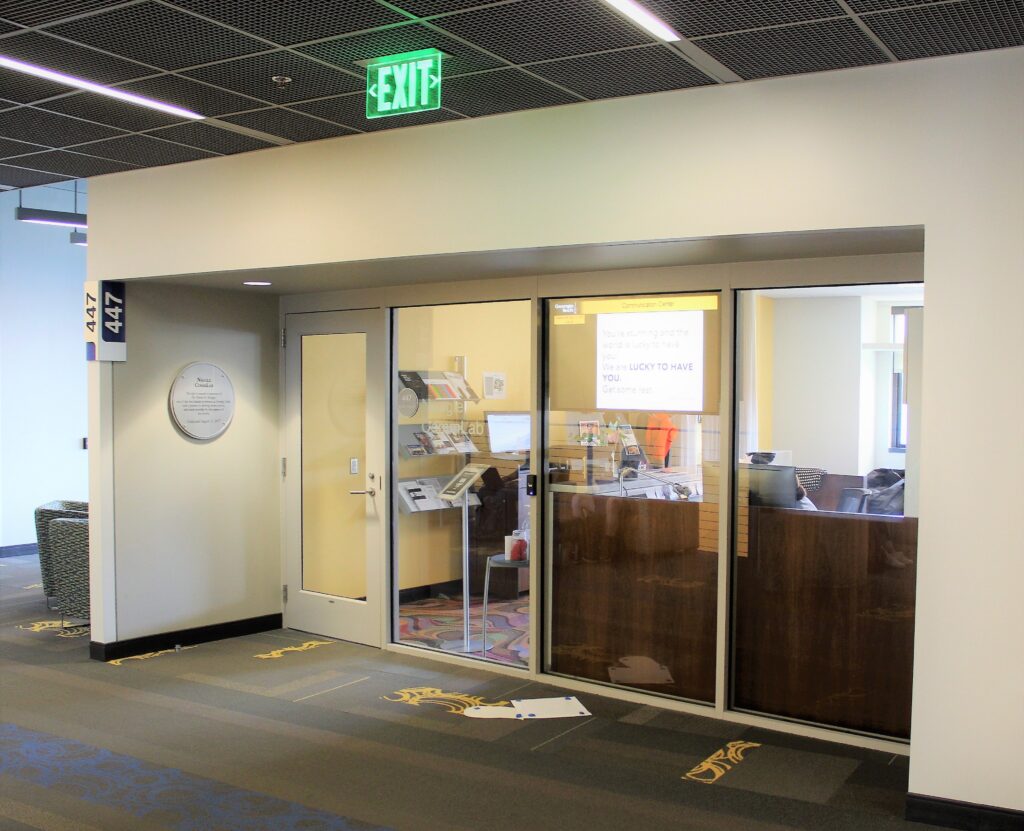
While it is still technically possible for students to make in-person appointments (if circumstances require it), the Communication Center’s consultation services are offered almost exclusively online.
by Genny Onyiuke-Kennedy, Emily Nguyen, Stephanie Oliva, Raneem Rizvi, Rocio Soto, Sophia Tone, Jeff Howard, and Eric Lewis
This article is the second installment of a two-part series on the views of six peer consultants who have worked at the Naugle Communication Center during its transition from in-person/face-to-face consultations to online consultations in response to the COVID-19 pandemic. This installment focuses on the peer consultants’ views about adapting their consulting styles to fit an online environment, working with students both asynchronously and synchronously, and speculating on the future of the Communication Center and the ways in which the shift to online consultations will affect how the Center serves its student populations.
How does working online influence your approach to and strategies in the appointment? How have you had to adapt your consulting style to be successful in an online consulting environment?

Emily Nguyen
Emily Nguyen: In terms of my style, I definitely don’t have one. I didn’t have one before [starting to tutor online]. I still felt really green behind the ears even going into the semester that we got sent home due to COVID-19, and I didn’t really feel in rhythm with consulting at all until maybe the end of the summer, where I felt like I am used to this now. I feel like I’m actually comfortable with giving advice now. It was just more of a process of developing my general style. I was very malleable.
Sophia Tone: I’ve learned to add as many affable/personable touches as I can to my feedback. I try to throw in some humor when I can, because an entire document of dry criticism (as constructive as I try to make it) sounds like a really dull thing to receive. I think having access to and control of the whole document at once has helped me better organize the appointment in my head. I glance over the whole document, read it over thoroughly, organize the paper’s main issues, give feedback on “global” issues first, and then pick out specific changes I’d make. With in-person consulting, my feedback strategy felt much more random and dependent on the client.
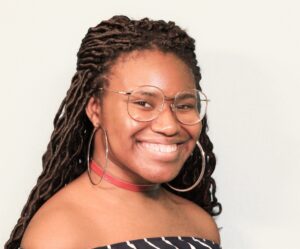
Genny Onyiuke-Kennedy
Genny Onyiuke-Kennedy: I feel like I’m a pretty expressive person, but I had to dial that up even more. When I’d be talking with people as an English conversation partner, it’s pretty important that, whatever I’m communicating, they get not just the words, but the emotion, the context, and the cultural impact. And that is part of the reason why synchronous appointments could get exhausting quickly, because I’m overexpressing to compensate for the fact that I’m not in–person with you. So, that is a part of [the reason], at least with synchronous consultations, that I had to change. There’s all sorts of things that I had to cut and trim and exaggerate. I basically have become more of a cartoonish version of myself, which can get tiring. That’s definitely something I had to change.
But in terms of asynchronous appointments, nothing has really changed. If anything, I just got quicker. Well, actually, maybe I got a little harsher on asynchronous, because when the person is there, you’re not going to say certain things. I think sometimes, because I had, say, twelve different comment blocks, versus maybe in-person we only had time to address six of them. It seems sometimes I’m being more abrasive, because I’m going in every single time. But I think that’s just the fact that you have the ability to do that because you’re not having to pause to address and explain and hear back.
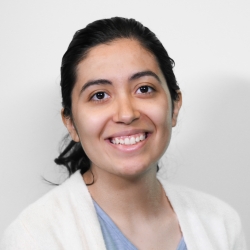
Rocio Soto
Rocio Soto: In the past, I would start reading the document. If we see something that’s super glaring, maybe we’ll stop to address it. Something along those lines. And so, with asynchronous, I found that when I’m reading as I go, I kind of start editing as I go. I kind of miss key things about the piece. It’s just easier if I read the piece in its entirety and then add my marks, along with my more substantive comments at the end. It’s definitely influenced the way I approach documents for the asynchronous appointments.
I know it’s changed how I approach appointments. I try to take a lot more initiative. You kind of have to maximize their time and yours. You’re kind of like, “All right, well, let’s get into it. What issues are you having?” and stuff like that. I take a lot more initiative than I used to.
Stephanie Oliva: My appointments are typically discussion-based when I work face–to–face. So, I have had to make a special effort to make my feedback as concise and understandable as possible, given that most of my appointments have been asynchronous.
What are your thoughts concerning asynchronous vs. synchronous consulting? Contrasting the two modes, what does each do better than the other? How do these modes force you to be flexible in the way you approach an appointment?
Genny: When it comes to asynchronous online consulting, I think that the consultant has a chance to do a deeper dive. I’m not saying that the client gets in the way or anything, but you can probably get more done , whether it’s a poster or a resume or a paper. By yourself, it is a bit more efficient, too.
Rocio: The nice thing about asynchronous [appointments] is that you have a little more time to read through the document and really form your thoughts. A lot of times, when you have a student there, you have a minute or two, while you’re trying to think of what to say to them, but they expect that immediate response. However, personally, I kind of prefer the video consultations, just because there’s a lot more communication back and forth. And if I don’t understand something, or they don’t understand something, we can communicate that with each other and find common ground. I’ve also found that, with the asynchronous, just with students and how much information they put in, you’re not always sure what kind of feedback they’re looking for. And that’s how I’ve always centered my appointments. That was a hard transition, because I would always ask, “What kind of feedback are you looking for?” Or, “What are you worried about?” Or, “What is stressing you out about this piece?” And a student would tell me, “Well, I kind of feel like this,” or “Oh, there’s this one paragraph.” And we always go off of those sorts of things. Asynchronous is a little different, where if they don’t immediately give you those details in the description box [in TutorTrac], then you’re kind of just like, “Okay, well, I’m just going to do something general.”
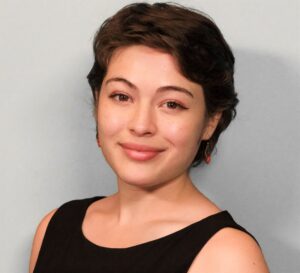
Stephanie Oliva
Stephanie: Synchronous appointments allow me to maintain some semblance of my typical consulting style which I appreciate very much. But I understand that not everyone feels the need to speak about their work directly. For these people, I feel that the asynchronous is absolutely beneficial when guidelines are followed.
Emily: Between BlueJeans [synchronous] and asynchronous I think, in BlueJeans, it’s a lot easier to focus on overarching problems with the paper. Something about just talking to a person and talking it out with them is a lot easier to just identify main concepts, whereas with asynchronous appointments, I feel like I have a tendency to hone in on grammar mistakes, like, “Oh, gosh, this needs a comma here.” In a BlueJeans appointment, I wouldn’t interrupt their flow of thought by saying, “You need a comma in this sentence.”
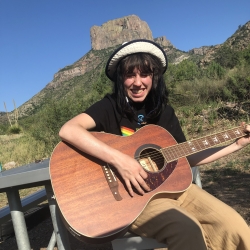
Sophia Tone
Sophia: Synchronous consulting definitely lends itself to dialogue in a way that asynchronous consulting never could. The client and consultant can work out the main issues in real time and figure out misunderstandings immediately. With asynchronous consulting, this back and forth is impossible and therefore a strong benefit of the doubt is required on both ends. Asynchronous consulting has forced me to stay open to all possible intentions the client might have had in their writing and to be generous in my feedback. The benefit of asynchronous work, as I mentioned earlier, is the level of focus that uninterrupted time alone allows for.
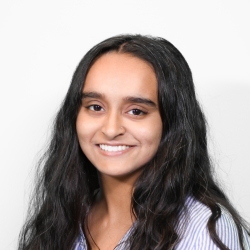
Raneem Rizvi
Raneem Rizvi: I think the asynchronous ones are completely different. I can’t ask them questions. I can’t get exactly what they need. It’s a bit more difficult because they’ll give me a brief description. I’ll be like, “Okay, I guess this is what you want.” You know, you have a general understanding, but you don’t really know. The BlueJeans ones, I would say, are pretty much the same as in person, just because I’m able to ask them questions, and they’re able to share their screen and show me the prompt. Or if they need to pull something up, they can show me all that. But the asynchronous ones, I’ve definitely had to guess what they want. From experience, if you have a type of assignment and they say, “Oh, this is a rubric and stuff,” my guess is they want me to check if they’re getting all the points in the rubric, but I guess it’s more up in the air than in person.
I don’t really try to ask too many questions, just because I know that might stress the person out if they literally got no feedback, just a bunch of questions. I might just be like, “Oh, it’s unclear what you’re trying to say. This is what I got out of it just so that they can read that feedback and be like, “Oh, that’s not what I meant. Maybe I should change that.” I don’t think for me personally, if I got a paper back, and it was just a bunch of questions, I would be like, “Oh, okay, I don’t understand what that is trying to do.” I would say I’m asking fewer questions than I would in person just because I don’t think that that’s what will help them. Of course, if that would help them, that’s good, but I try to make more definitive statements rather than just ask questions.
Do you prefer consulting asynchronously or synchronously?
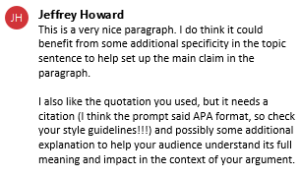
For asynchronous appointments, consultants use the Track Changes functionality in Microsoft Word to give feedback to clients.
Emily: I like asynchronous, just because I don’t like the hassle of technology. I like to think of myself as a technologically savvy person, but then COVID-19 hit, and now I’m suddenly a Boomer, because I don’t like using all of these things. But I do really like talking to people, especially clients that are very interested in their projects. It’s really interesting to just hear what they have to say about their work.
I’m not sure if I could pick one. There are definitely times where it’s just—I can’t do a BlueJeans appointment right now. But I have to. But during the summer, when I had like four asynchronous in a row, I was like, “I wish I had a BlueJeans appointment to spice this up.”
Sophia: I prefer asynchronous consulting.
Stephanie: I see the benefit in both. My priorities are the clients’ priorities, so whatever they prefer is fine with me. I do miss talking to people, though.
Raneem: I think synchronous is a lot easier for the client, as well. It depends on what the person wants, because if they’re just like, “Oh, look over my resume,” then I don’t think I need to sit there and talk to them for 45 minutes. I think they really just want someone to look at it. And the people that have made synchronous appointments have needed to talk through it. I feel like people are proactive about what they need more. I had a [client who needed a] mock interview. She’s obviously not going to make it asynchronous. It just wouldn’t make any sense. I had one for a scholarship essay just now. And I think he just wanted to talk through it himself, which is why he made the BlueJeans [appointment]. But then I’ve had people who just have a methodology section of the lab report and have very clearly said, “Oh, can you just make sure I hit all the points?” And I feel like that’s more beneficial for an asynchronous one. I mean I like asynchronous, as well, just because there’s not that pressure of a person there. And it’s something new that we haven’t ever had, so it’s kind of nice.
How do you think the current model of online consulting will influence the future of the CommLab? Can we go back to the way it was? Should we?
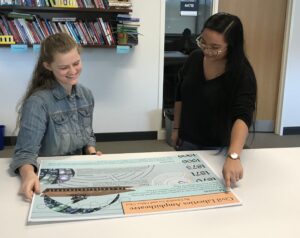
While all of the peer and professional consultants miss the community created within the Center’s physical space and the dynamics of in-person appointments, online consultations still allow the Center to meet the communication needs of Georgia Tech students, even during this ongoing health crisis. Photo taken by Cassidy Reese, 2019.
Emily: I’m sure we’ll certainly have face-to-face again, because that’s what we all miss. But like what I said earlier, I think we should include both services: online and face-to-face.
Sophia: I hope that even when we’re able to meet in person, we can maintain some level of online consulting. I think we’ve proven that we can do it successfully, and I know it’s been incredibly convenient for students at home and abroad. Clients in different time zones are easily able to get help with their work in a way they couldn’t before. Online consulting is inclusive and accessible, and it needs to continue in some form.
Stephanie: I think most of the people who interact with the CommLab will agree that it is a very upbeat and supportive environment. I really miss spending time in the space and being able to support students face–to–face there. In the future, I think the CommLab should definitely go back to offering in-person appointments. But, I also think that providing students the flexibility to attend appointments from their own locations is beneficial, especially during very stressful periods of the semester. I would like to see this option sustained. I know extending the service that the CommLab offers would allow us to help people with end-of-semester projects more.
Genny: If I were to anticipate any sort of changes within CommLab, I would expect online tutoring to become more versatile. It wouldn’t just be BlueJeans, sit down, do a call — there could be all sorts of things that you could meddle with. Or you could be interacting on a more creative span. Let’s say you want to brainstorm with somebody, you might use some online chalkboard thing. And then it’s like you’re drawing, they’re drawing, and we might even have new software for that, tablets and drawing tools and stuff. Who knows? That might be cool. That sounds like it could be fun.
But I also think that the in-person aspect is never going to go away. At least, I hope not. The fact that we work in communication necessitates that we have an in-person component. Because at the end of the day, face-to-face communication is what makes or breaks some things because —whether it’s a job or it’s a presentation—you’re giving a piece of you, and there is some of that lost digitally, not because of anything wrong with you, but rather [because of] the medium that we’re working in. The only other thing that I would expect then is if we’re doing in-person, then maybe we might start doing in-person in places that aren’t the CommLab. If we were to go to residence halls, I know that we’ve always talked about that before, or in different academic buildings and be like, “Hey, there’s two consultants here, from six to nine. Hang out here, and they can look at your stuff.” You know, trying to address that accessibility part of online tutoring, but without making it online again.
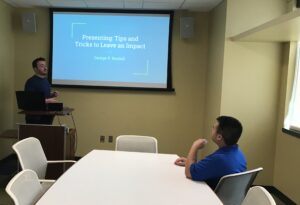
During the COVID-19 pandemic, the Communication Center will continue to offer its services online, but there is no doubt that in the future in-person appointments will be offered again, once it is deemed safe to resume operations in the physical Center. Photo taken by Cassidy Reese, 2019.
Raneem: I have no idea. I don’t even know when that would happen. Hopefully sometime soon, but I don’t even know. I mean, I’d love to work in–person again. I feel like that was just a great way, especially with group projects. I know group meetings over BlueJeans is not the most fun. I would say a lot of places of work are going to be adopting some type of work-from-home thing now. Now that we know we can do it, I think the asynchronous thing is awesome, because people that aren’t able to get on campus or don’t have time to come in and get their papers looked at can make an appointment. I feel like if we go back to in–person, the CommLab should adopt an asynchronous type of thing. Or maybe even BlueJeans appointments, just for people that are at home, commuting, and can’t make it. I think that would save people a lot of time and be able to get a lot more people into the Center.
Rocio: I think to some extent, we should [continue online consultations], just because it’s an accessibility thing. It’s also just like, a mental health thing, too. I have had appointments, especially over the summer, where it’s like an international student who’s like, “I’ve been stuck in my apartment this entire time. I don’t want to go out.” I had one where she and I were talking, and it was just conversation practice in English because she had no one to practice with. That was a big thing I realized over the summer, especially with this student. You could just tell that she was looking for someone to talk to. We ended up talking for like an hour, and I eventually had to say, “Okay, well, I gotta go, but it was really nice talking to you.” It’s just, I think it has taken a mental health toll.
I will say I think we, the work we’ve done on BlueJeans has been really great too, and I think it’s a resource we should keep using, especially when it comes to accessibility. I’m a commuter student. I live in Marietta. Something that would always have been nice, I think, is if I don’t have classes one day, but I want to come in for an appointment, I can make an appointment and meet with a consultant online. And even for more serious accessibility issues—I don’t know if Georgia Tech is always the most accessible campus when it comes to disabled people. Trying to get around, especially when you’re talking about the steps near the CULC and [places] like that, that can take some time; that can be a bit difficult. And it’s one of our initial points when we were thinking about having an online option. There are students who, literally, it takes them 40 minutes instead of 20, to walk to the CULC. That’s not the most convenient for them. There are all these things to factor in. And there are anxiety issues and stuff like that for people, as well, so I think this is a resource we should keep using.
Epilogue
Five of the six consultants interviewed for this series still work at the Naugle Communication Center (Genny graduated from Georgia Tech earlier this year). While the Center’s administrators have currently made no decisions regarding the permanent status of online consulting practices for the future, the Center will continue to provide online consultations, asynchronous and synchronous, as long as it remains the best option for protecting the health and safety of the consultants and the students they serve.
